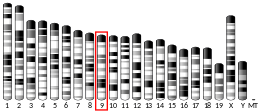Neurotrimin
Neurotrimin is a protein that in humans is encoded by the NTM gene.[5][6]
This gene encodes a member of the IgLON (LAMP, OBCAM, Ntm) family of immunoglobulin (Ig) domain-containing glycosylphosphatidylinositol (GPI)-anchored cell adhesion molecules. The encoded protein may promote neurite outgrowth and adhesion via a homophilic mechanism. This gene is closely linked to a related family member, opioid binding protein/cell adhesion molecule-like (OPCML) on chromosome 11. Multiple alternatively spliced variants have been found but only two variants have had their full-length sequences determined.[6]
References
- GRCh38: Ensembl release 89: ENSG00000182667 - Ensembl, May 2017
- GRCm38: Ensembl release 89: ENSMUSG00000059974 - Ensembl, May 2017
- "Human PubMed Reference:". National Center for Biotechnology Information, U.S. National Library of Medicine.
- "Mouse PubMed Reference:". National Center for Biotechnology Information, U.S. National Library of Medicine.
- Struyk AF, Canoll PD, Wolfgang MJ, Rosen CL, D'Eustachio P, Salzer JL (Apr 1995). "Cloning of neurotrimin defines a new subfamily of differentially expressed neural cell adhesion molecules". J Neurosci. 15 (3 Pt 2): 2141–56. doi:10.1523/JNEUROSCI.15-03-02141.1995. PMID 7891157.
- "Entrez Gene: HNT neurotrimin".
Further reading
- Bonaldo MF, Lennon G, Soares MB (1997). "Normalization and subtraction: two approaches to facilitate gene discovery". Genome Res. 6 (9): 791–806. doi:10.1101/gr.6.9.791. PMID 8889548.
- Wistow G, Bernstein SL, Wyatt MK, et al. (2002). "Expressed sequence tag analysis of human RPE/choroid for the NEIBank Project: over 6000 non-redundant transcripts, novel genes and splice variants". Mol. Vis. 8: 205–20. PMID 12107410.
- Strausberg RL, Feingold EA, Grouse LH, et al. (2003). "Generation and initial analysis of more than 15,000 full-length human and mouse cDNA sequences". Proc. Natl. Acad. Sci. U.S.A. 99 (26): 16899–903. doi:10.1073/pnas.242603899. PMC 139241. PMID 12477932.
- Sellar GC, Watt KP, Rabiasz GJ, et al. (2003). "OPCML at 11q25 is epigenetically inactivated and has tumor-suppressor function in epithelial ovarian cancer". Nat. Genet. 34 (3): 337–43. doi:10.1038/ng1183. PMID 12819783.
- Clark HF, Gurney AL, Abaya E, et al. (2003). "The secreted protein discovery initiative (SPDI), a large-scale effort to identify novel human secreted and transmembrane proteins: a bioinformatics assessment". Genome Res. 13 (10): 2265–70. doi:10.1101/gr.1293003. PMC 403697. PMID 12975309.
- Zhang Z, Henzel WJ (2005). "Signal peptide prediction based on analysis of experimentally verified cleavage sites". Protein Sci. 13 (10): 2819–24. doi:10.1110/ps.04682504. PMC 2286551. PMID 15340161.
- Liu J, Li G, Peng X, et al. (2004). "The cloning and preliminarily functional analysis of the human neurotrimin gene". Science in China Series C: Life Sciences. 47 (2): 158–64. doi:10.1360/03yc0072. PMID 15379248.
- Gerhard DS, Wagner L, Feingold EA, et al. (2004). "The status, quality, and expansion of the NIH full-length cDNA project: the Mammalian Gene Collection (MGC)". Genome Res. 14 (10B): 2121–7. doi:10.1101/gr.2596504. PMC 528928. PMID 15489334.
This article is issued from Wikipedia. The text is licensed under Creative Commons - Attribution - Sharealike. Additional terms may apply for the media files.




